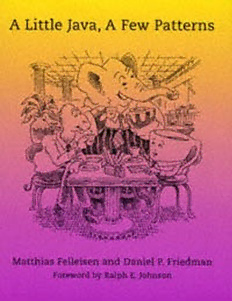
A little Java, a few patterns PDF
Preview A little Java, a few patterns
A Little Java, A Few Patterns Matthias Felleisen Rice University Houston, Texas Daniel P. Friedman Indiana University Bloomington, Indiana Drawings by Duane Bibby Foreword by Ralph E. Johnson The MIT Press Cambridge, Massachusetts London, England @ 1998 Massachusetts Institute of Technology All rights reserved. No part of this book may be reproduced in any form by any electronic or mechanical means (including photocopying, recording, or information storage and retrieval) without permission in writing from the publisher. This book was set by the authors and was printed and bound in the United States of America. Library of Congress Cataloging-in-Publication Data Felleisen, Matthias A little Java, a few patterns. / Matthias Felleisen and Daniel P. F'riedman; drawings by Duane Bibby; foreword by Ralph E. Johnson p. cm. Includes index and bibliographical references. ISBN 0-262-56115-8 (pbk : alk. paper) 1. Java (Computer program language) I. Fkiedman, Daniel P. 11. Title. QA76.73.J 38F45 1998 005.13'3-dc21 97-40548 CIP To Helga, Christopher, and Sebastian. To May, Rob, Rachel, Sara, and to the memory of Brian. This page intentionally left blank Contents Foreword ix Preface xi Experimenting with Java xiii 1. Modern Toys 3 2. Methods to Our Madness 13 3. What’s New? 43 4. Come to Our Carousel 57 5. Objects Are People, Too 69 6. Boring Protocols 85 7. Oh hfy! 99 8. Like Father, Like Son 117 9. Be a Good Visitor 139 10. The State of Things to Come 161 Commencement 177 Index 178 This page intentionally left blank FOREWORD Learning to program is more than learning the syntactic and seniantic rules of a prograninling language. It also requires learning how to design programs. Any good book on programming must therefore teach program design. Like any other form of design, program design has conipeting schools. These schools are often associated with a particular set of languages. Sincc .Java is an object-oriented prograniniing language, people teaching Java should emphasize object-oriented design. Felleisen and Friedmari show that the functional (input-output driven) inet hod of program design naturally leads to the use of well-known object-oriented design patterns. In fact, the!. integrate the two styles seamlessly and show how well the). work together. Their book pro\-es that the functional design method does not clash with, but supports object-oriented programming. Their success doesn't surprise me, because I've seen it ill Snialltalk for niany years. though unfortunately, it seems to have remained one of the secrets of object-oriented design. I am happy to see that Felleisen and F'riedman have finally exposed it. This book will be especially useful if you are a C++ programmer learning Java, since you probably haven't seen functional program design before. If you know functional design, the book will gently introduce you to pattern-based programming in Java. If you don't know it. Felleisen and Friednian will teach you a powerful new way of thinking that you should add to \.our design toolbos. Enjoy the pizzas! Ralph E. Johnson Chanipaign, Illinois is This page intentionally left blank Preface An object-oriented programming language enables a programmer to construct reusable program components. With such components, other programmers can quickly build large new programs and program fragments. In the ideal case, the programmers do not modify any existing code but simply glue together components and add a few new ones. This reusability of components, however, does not come for free. It requires a well-designed object-oriented language and a strict discipline of programming. Java is a such a language, and this book introduces its object-oriented elements: (abstract) classes, fields, methods, inheritance, and interfaces. This small core language has a simple semantic model, which greatly helps programmers to express themselves. In addition, Java implement at ions automatically manage the memory a program uses, which frees programmers from thinking about machine details and encourages them to focus on design. The book’s second goal is to introduce the reader to design patterns, the key elements of a programming discipline that enhances code reuse. Design pat terns help programmers organize their object-oriented components so that they properly implement the desired computational process. More importantly still, design patterns help communicate important properties about a program component. If a component is an instance of an explicitly formulated pattern and documented as such, other programmers can easily understand its structure and reuse it in their own programs, even without access to the component’s source. THEI NTENDEDA UDIENCE The book is primarily intended for people-practicing programmers, instructors and students alike-who wish to study the essential elements of object-oriented programming and the idea of design patterns. Readers must have some basic programming experience. They will benefit most from the book if they understand the principles of funct,ional design, that is, the design of program fragments based on their input-output behavior. An introductory computer science course that uses Scheme (or ML) is the best way to get familiar with this style of design, but it is not required. WHAT THIS BOOK IS NOT ABOUT Java provides many useful features and libraries beyond its object-oriented core. While these additional Java elements are important for professional programming, their coverage would distract from the book’s important goals: object-oriented programming and the use of design patterns. For that reason, this book is not a complete introduction to Java. Still, readers who master its contents can quickly become skilled Java programmers with the supplementary sources listed in the Commencement. The literature on design patterns evolves quickly. Thus, there is quite a bit more to patterns than an introductory book could intelligibly cover. Yet, the simplicity of the patterns we use and the power that they provide should encourage readers to study the additional references about patterns mentioned at the end of the book. ACKNOWLEDGMENTS We are indebted to many people for their contributions and assistance throughout the devel- opment of this book. Several extensive discussions with Shriram Krishnamurt hi, Jon Rossie, xi
